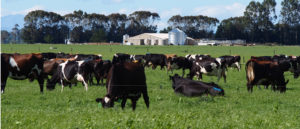
Mention mastitis on any farm and discussion almost immediately turns to bacteria and which might be responsible for the given scenario. However, this is not necessarily the correct link to make. Mastitis simply describes inflammation of the mammary tissue. Although bacteria may be (and often are) responsible for causing that inflammation, there are other causes such as trauma caused by a kick. Antibiotics do not treat inflammation, but, when present, they do a good job of dealing with the bacteria. The resolution of that infection will in time allow the inflammation in the udder to heal, but why do we not always treat the inflammation itself? There is no good answer to this question – instead we should actually change the behaviour and make direct treatment of the inflammation the norm. We have good effective molecules for doing this in the non-steroidal anti-inflammatory (commonly shortened to anti-inflammatory) group of drugs, egMetacam®, Key®, Norflunix®, Tolfedine®, to name just a few.
Some modelling done with market research data in 2017 estimated that anti-inflammatory drugs are used in around only 20% of situations on dairy farms in which treatment would have had some benefit. This means that these drugs should be used five times as frequently as they are being at present.
Anti-inflammatories are rightly associated with pain relief; however, their effects are wide and many, and this is why they are beneficial. Relieving pain is in itself beneficial. We are all familiar with having a sports injury or headache that makes us feel like moping. Taking some pain relief such as Voltaren® or Nurofen® dulls that ache away and we get on with our work. Similarly, when we have the flu or some other infection raising our temperature to a fever, those same drugs help alleviate that temperature and again we feel like getting on with things. A study in 2003 established that cows with mild to moderate mastitis (classified by degree of observable change in milk and udder appearance) had increased sensitivity to measured pressure applied to the affected quarter compared to their unaffected quarters, and they tended to stand with their hind legs further apart than unaffected cows. These observations confirmed the pain associated with mastitis in cows (human mums suffering mastitis certainly experience pain). The same study also showed rectal temperatures tended to be raised in those cows with mastitis. While it is perhaps anthropomorphising, there is no reason not to expect that relieving that pain and fever in animals by treating with an anti-inflammatory might also make them feel more inclined to get back to work. In the case of livestock, their work is grazing – it occupies the vast majority of their waking time. So being freed of pain is likely to help them graze for longer and maintain condition and production through their illness.
Anti-inflammatories also relieve the swelling associated with inflammation. While we all readily recognise a swelling on the outside of an animal, swelling in the udder also occurs internally and causes the milk ducts to swell shut. This not only retains pus and infective material deep in the udder, but it also prevents the ingress of intramammary treatments to the site of infection. So, relief of this swelling has direct therapeutic effects by allowing material to drain from the udder and antibiotics to penetrate and treat the site more effectively. This was demonstrated in a 2016 study that involved 7,800 cows from six different countries around the world. This study found that treating with Meloxicam (an anti-inflammatory) as well as antibiotic resulted in 16% more bacterial cures than when animals were treated with the antibiotic alone.
As stated earlier, there is a wide array of anti-inflammatories available. To choose which one to use may be difficult, but it is probably fair to say that using any is better than using none. Likewise, it is fair to say that they will seldom do much harm in dairy cattle. Their main side effects are kidney damage and stomach ulcers. Given the relatively short period of treatment in cows, these risks are small compared to the benefits that the drugs are likely to deliver. So, discuss with your Vetlife veterinarian which drugs you could use in your farming operation and how and when you could use them more to benefit production and welfare.
Duncan Crosbie, Vetlife Temuka
NSAID Use on NZ Dairy Farms
Lawrence L
NZVA Dairy Cattle Vets Newsletter, Volume 34, Issue 4, pp 34-35, Jun 2017
Objective measurement of pain in mild and moderate cases of clinical mastitis in dairy cows
Milne MH, Nolan AM, Cripps PJ, Fitzpatrick JL
International Symposia on Veterinary Epidemiology and Economics proceedings, ISVEE 10: Proceedings of the 10th Symposium of the International Society for Veterinary Epidemiology and Economics, Vina del Mar, Chile, Animal welfare session, p 446, Nov 2003
Addition of meloxicam to the treatment of clinical mastitis improves bacteriological cure
McDougall S, Abbeloos E, Piepers S, Rao AS, Astiz S, van Werven T, Statham J, Perez-Villalobos N
Proceedings of the Society of Dairy Cattle Veterinarians of the NZVA Annual Conference, 2016 Proceedings of the Society of Dairy Cattle Veterinarians of the NZVA Annual Conference, Jan 2016